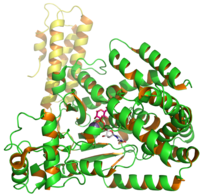
Photo from wikipedia
STUDY DESIGN Retrospective analysis. OBJECTIVES To calculate the range of minimum clinically important difference threshold values using anchor-based and distribution-based methods for back pain, leg pain, the Oswestry Disability Index… Click to show full abstract
STUDY DESIGN Retrospective analysis. OBJECTIVES To calculate the range of minimum clinically important difference threshold values using anchor-based and distribution-based methods for back pain, leg pain, the Oswestry Disability Index (ODI), and the Scoliosis Research Society 22R instrument (SRS-22R) in patients with de novo degenerative lumbar scoliosis (DNDLS) who underwent long-segment fusion surgery. Then we sought to determine a statistically sound meaningful minimum clinically important difference in patient-reported outcome measures (PROMs) and compare our results with previously reported values for other adult spine deformity (ASD) populations. SUMMARY OF THE BACKGROUND DATA Minimum clinically important difference thresholds for back pain, leg pain, and the ODI and SRS-22R have not been widely described in patients with ASD. METHODS PROMs were obtained preoperatively and 2 years postoperatively in 128 patients with DNDLS. We applied different minimum clinically important difference calculation methods to the data, and the results were compared. RESULTS There was a statistically significant improvement in the 2-year postoperative PROM scores compared to the preoperative scores. Different preoperative calculation methods yielded an approximately 10-fold range of values. Minimum clinically important difference values were established as 1.9 for back pain, 1.5 for leg pain, 18.9 for the ODI, 0.8 for SRS-22R pain, 0.5 for SRS-22R activity, 1.6 for SRS-22R appearance, 0.8 for SRS-22R mental, and 0.98 for the SRS-22R subtotal. Compared with the previously reported minimum clinically important differences in ASD, the values for back pain, ODI, and SRS-22R appearance were higher in patients with DNDLS. CONCLUSIONS Sensitivity- and specificity-based methods provide statistically sound minimum clinically important difference thresholds for the DNDLS population. The minimum clinically important difference thresholds for PROMs in patients with DNDLS were different from the threshold values previously reported for adult patients with spinal deformities.
Journal Title: Spine
Year Published: 2023
Link to full text (if available)
Share on Social Media: Sign Up to like & get
recommendations!